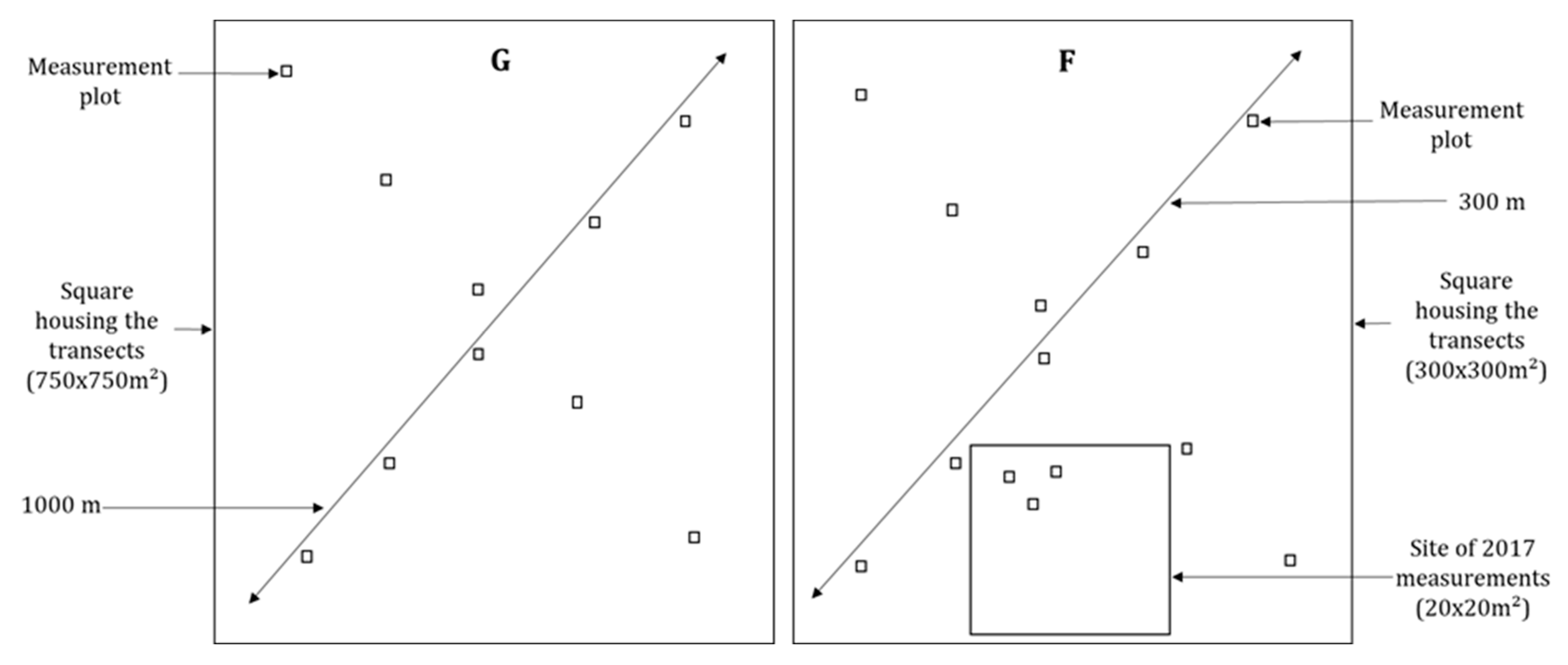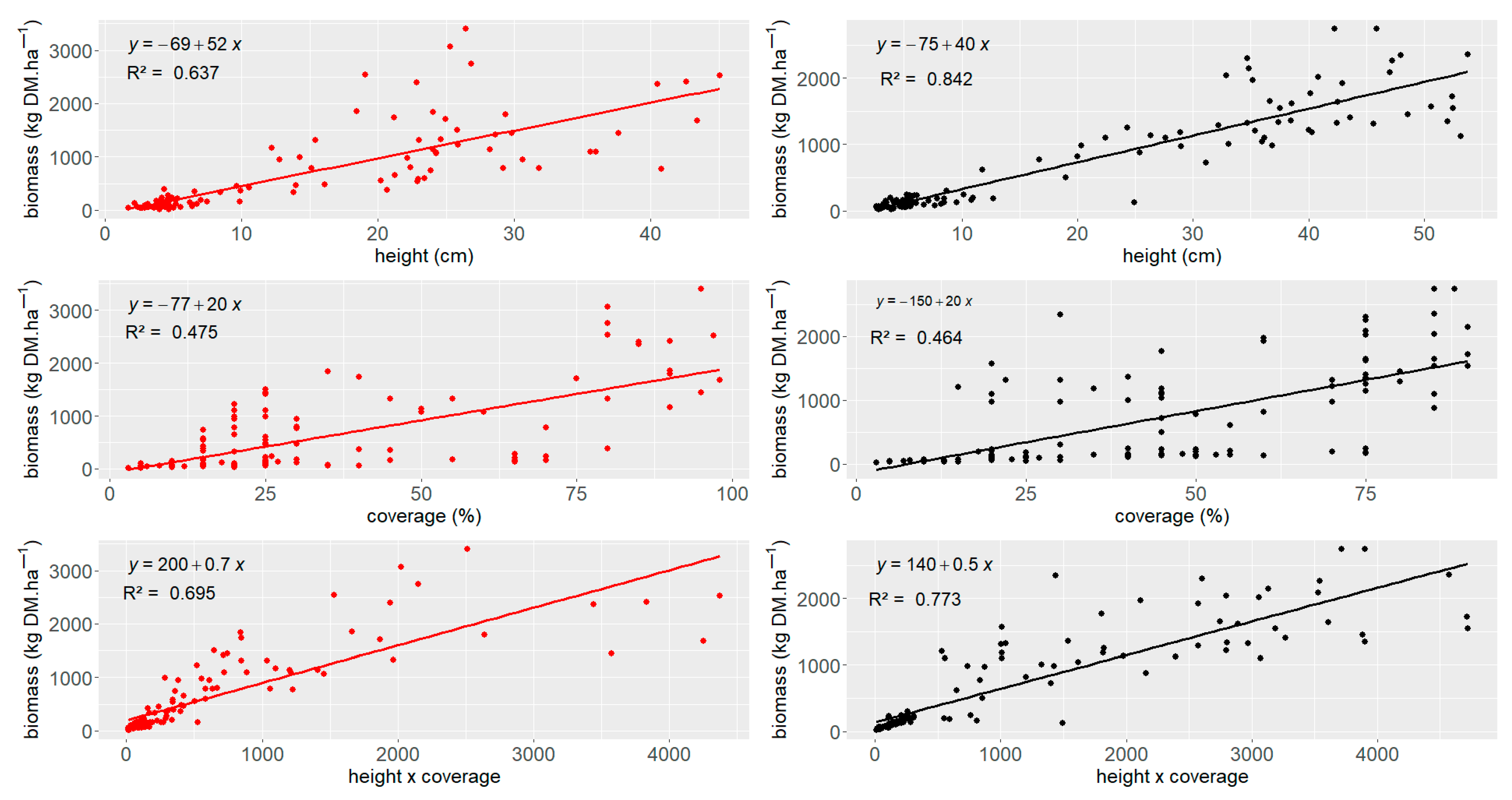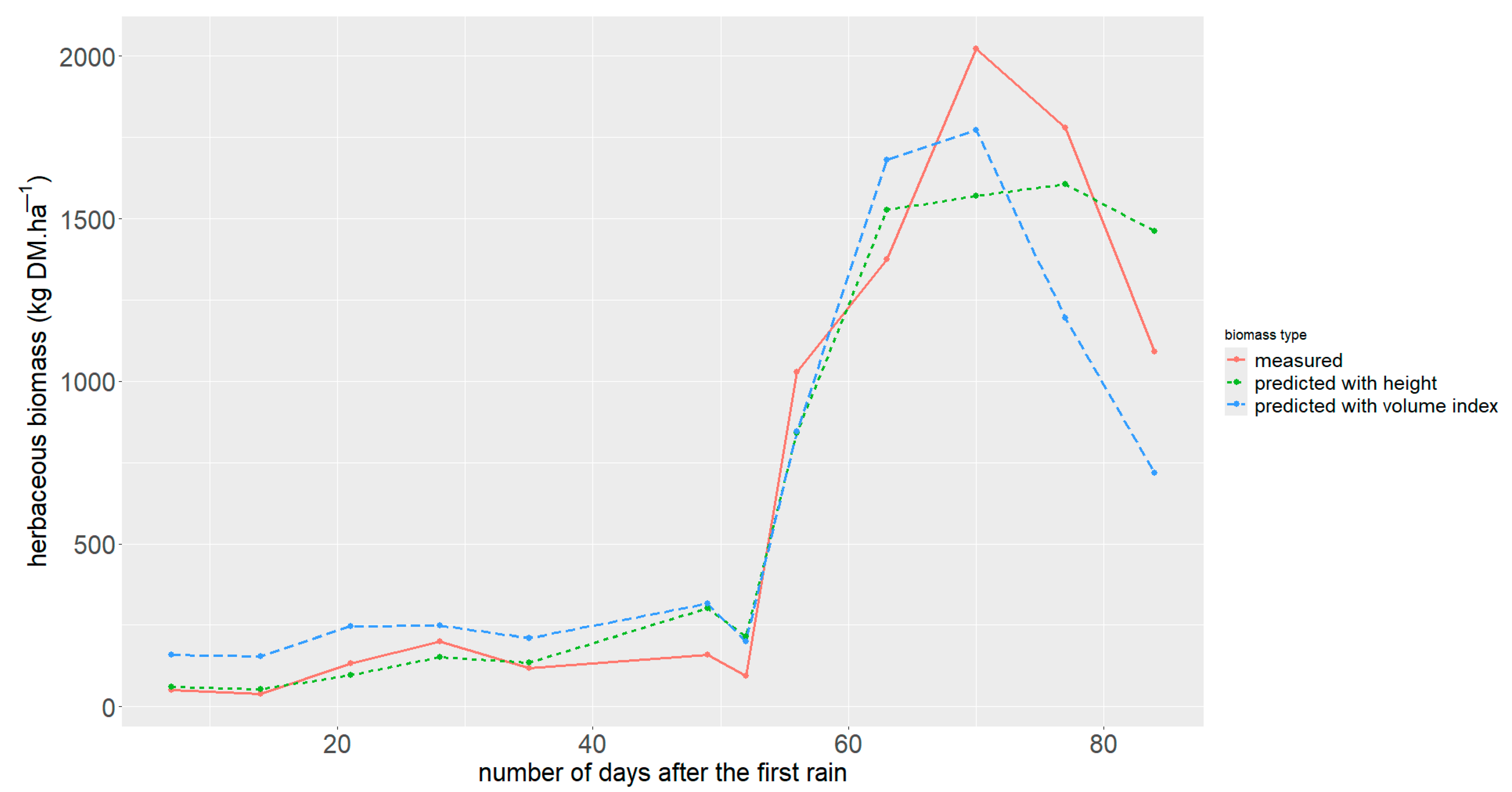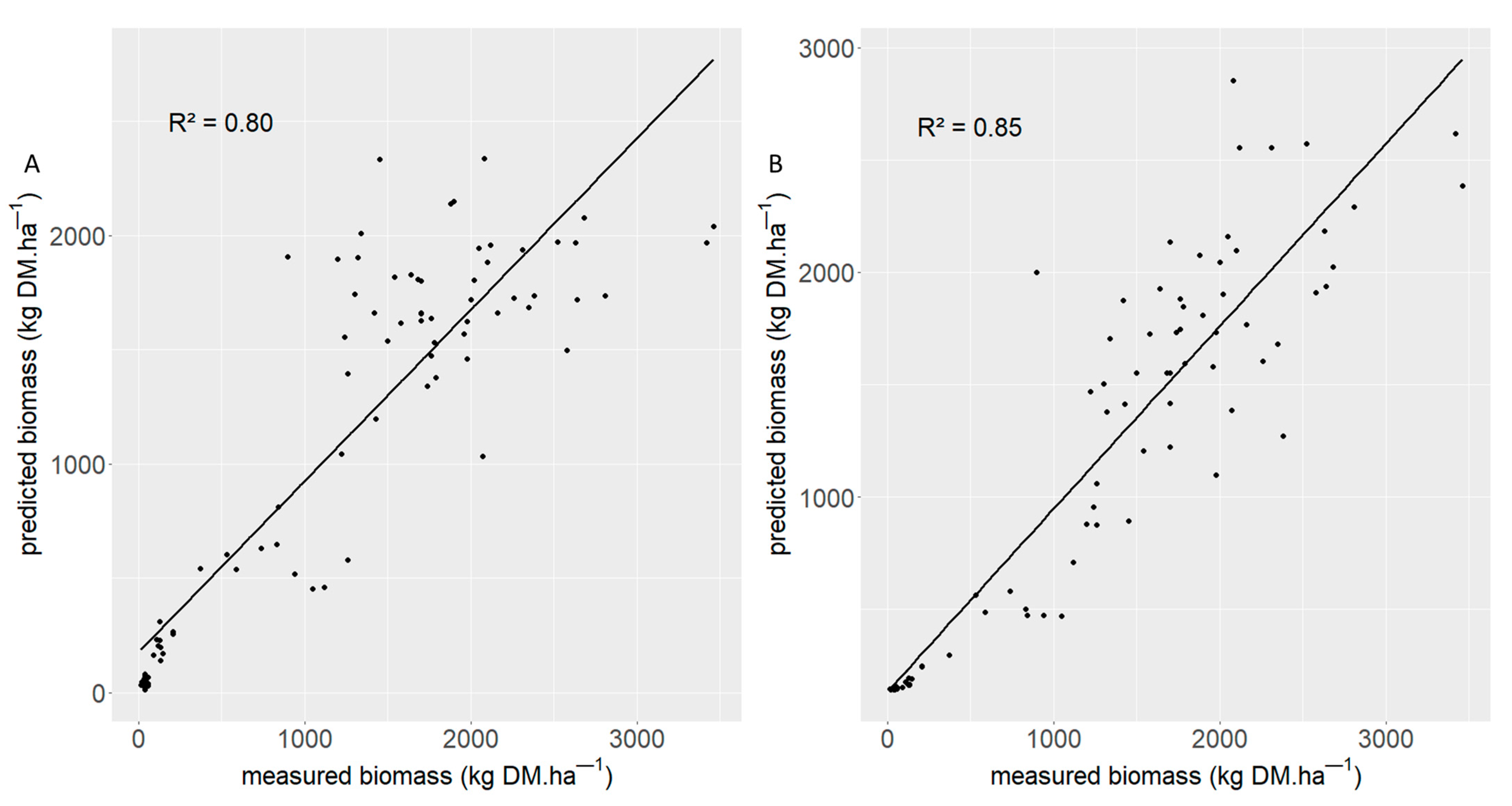Estimating Herbaceous Aboveground Biomass Using an Indirect Method Based on the Herbaceous Layer Characteristics
Abstract
1. Introduction
2. Materials and Methods
2.1. Study Area
2.2. Data Collection
- The dry weight of the herbaceous biomass (unit: kg dry mass (DM) per hectare) following [6], obtained after drying the harvested fresh biomass in an oven at 65 °C between 24 and 72 h depending on the amount of biomass;
- The plant height (between the ground and the upper part of the plant) as the average height of 10 randomly selected plants (unit: cm);
- The vegetation coverage (unit: %) is visually estimated as the percentage of ground covered by the herbaceous plants. The visual estimation of the ground coverage is generally well correlated with that obtained based on photos (correlation coefficient between visual estimates and photos equal to 0.94) and can therefore be used in the field [3];
- A volume index calculated by multiplying the height with the vegetation coverage [7].
2.3. Data Analysis
3. Results
3.1. Relationships of Herbaceous Biomass with Height, Vegetation Coverage, and Volume Index in 2018
3.2. Comparison of the Models Between Grazed and Fenced Sites
3.3. Model Evaluation Against Measured Herbaceous Biomass in 2017
3.4. Model Evaluation Against Measured Herbaceous Biomass in 2019
3.5. Models Validation
4. Discussion
5. Conclusions
Author Contributions
Funding
Data Availability Statement
Acknowledgments
Conflicts of Interest
References
- Hiernaux, P.; Le Houérou, H.N. Les parcours du Sahel. Sécheresse 2006, 17, 51–71. [Google Scholar]
- Le Houérou, H.N. The Rangelands of the Sahel. J. Range Manag. 1980, 33, 41–46. [Google Scholar] [CrossRef]
- Ndiaye, C.; Guèye, E.F.; Ngom, S.; Traoré, E.H.; Akpo, L.E. Impact of rainfall on grassland biomass production in the Sahel: A case in Matam Region, Northern Senegal. Livest. Res. Rural. Dev. 2015, 27, 55. [Google Scholar]
- Diatta, O. Dynamique Saisonnière et Interannuelle de la Strate Herbacée des Parcours Sahéliens du Sénégal (Crz-Dahra, Nord-Sénégal). Ph.D. Thesis, Université Cheikh Anta Diop, Dakar, Senegal, 2021; 105p. [Google Scholar]
- Ndiaye, O. Déterminants de la Dynamique de la Végétation d’un Milieu Pâturé en Région Sahélienne du Sénégal. Ph.D. Thesis, Université Cheikh Anta Diop, Dakar, Senegal, 2015; 133p. [Google Scholar]
- Levang, P.; Grouzis, M. Methods of studying the herbaceous biomass of Sahelian formations: Application to the Oursi pond, Upper Volta. Acta Oeco/Oecol Plant 1980, 3, 231–244. [Google Scholar]
- Büchi, L.; Mouly, P.; Amossé, C.; Bally, C.; Wendling, M.; Charles, R. Méthode non destructive d’estimation de la biomasse de couverts végétaux. Rech. Agron. Suisse 2016, 7, 136–143. [Google Scholar]
- Reinermann, S.; Asam, S.; Kuenzer, C. Remote sensing of grassland production and management-A review. Remote Sens. 2020, 12, 1949. [Google Scholar] [CrossRef]
- Taugourdeau, S.; Diedhiou, A.; Fassinou, C.; Bossoukpe, M.; Diatta, O.; N’Goran, A.; Audebert, A.; Ndiaye, O.; Diouf, A.A.; Tagesson, T.; et al. Estimating herbaceous aboveground biomass in Sahelian rangelands using structure from motion data collected on the ground and by UAV. Ecol. Evol. 2022, 12, e8867. [Google Scholar] [CrossRef] [PubMed]
- Ruster, J. Evolution du Couvert Végétal de la Région de Téssékré au Sénégal, par le Biais de la Télédétection. Master’s Thesis, Université Diderot-Paris 7, Paris, France, 2009; 60p. [Google Scholar]
- Bakhoum, A. Dynamique des Ressources Fourragères: Indicateur de Résilience des Parcours Communautaires de Tessekere au Ferlo, (Nord-Sénégal). Ph.D. Thesis, Université Cheikh Anta Diop, Dakar, Senegal, 2013; 115p. [Google Scholar]
- Sarr, M.A. Évolution Récente du Climat et de la Végétation au Sénégal (Cas du Bassin Versant du FERLO) (Vol. 3). Ph.D. Thesis, Université de Lyon, Université Cheikh Anta Diop, Dakar, Senegal, 2009; 384p. [Google Scholar]
- Casenave, A.; Valentin, C. Les états de surface de la zone sahélienne. In Influence Sur L’infiltration; Collection Didactiques; Orstom: Paris, France, 1989; 229p. [Google Scholar]
- R. C. Team. R: A Language and Environment for Statistical Computing; R Foundation for Statistical Computing: Vienna, Austria, 2021; Available online: https://www.R-project.org/ (accessed on 4 November 2024).
- Cornet, A. Le Bilan Hydrique et Son Rôle Dans la Production de la Strate Herbacée de Quelques Phytocénoses Sahéliennes au Sénégal. Ph.D. Thesis, Université des Sciences et Techniques du Languedoc, Montpelliern, France, 1981; 351p. [Google Scholar]
- Nafus, A.M.; McClaran, M.P.; Archer, S.R.; Throop, H.L. Multispecies allometric models predict grass biomass in semidesert rangeland. Rangel. Ecol. Manag. 2009, 62, 68–72. [Google Scholar] [CrossRef]
- Gupta, A.; Sagar, R.; Pandey, A. Unraveling the Relationship between Percentage Cover and Biomass of Various Herbaceous Species in the Dry Tropical Grassland. Int. J. Plant Environ. 2023, 9, 133–142. [Google Scholar] [CrossRef]
- Dumont, B. Préférences et Sélection Alimentaire au Pâturage. INRA Prod. Anim. 1996, 9, 359–366. [Google Scholar] [CrossRef]






| Models | p-Value (Between Grazed and Fenced Sites) |
|---|---|
| Biomass × height | <2.2e−16 |
| Biomass × coverage | <2.2e−16 |
| Biomass × volume index | <2.2e−16 |
| 2017 | 2019 | |||
|---|---|---|---|---|
| Measured Biomass/Predicted Biomass with Height | Measured Biomass/Predicted Biomass with Volume Index | Measured Biomass/Predicted Biomass with Height | Measured Biomass/Predicted Biomass with Volume Index | |
| Person coefficient (r) | 0.953 | 0.955 | 0.893 | 0.923 |
| Absolute average difference (kg DM·ha−1) | 211.44 | 96.69 | 120.62 | 87.61 |
| Relative difference (%) | 30.5 | 11.96 | 11.35 | 8 |
Disclaimer/Publisher’s Note: The statements, opinions and data contained in all publications are solely those of the individual author(s) and contributor(s) and not of MDPI and/or the editor(s). MDPI and/or the editor(s) disclaim responsibility for any injury to people or property resulting from any ideas, methods, instructions or products referred to in the content. |
© 2024 by the authors. Licensee MDPI, Basel, Switzerland. This article is an open access article distributed under the terms and conditions of the Creative Commons Attribution (CC BY) license (https://creativecommons.org/licenses/by/4.0/).
Share and Cite
Diatta, O.; N’goran, A.A.-J.; Fassinou, C.; Salgado, P.; Ndiaye, O.; Diatta, S.; Ngom, D.; Tagesson, T.; Taugourdeau, S. Estimating Herbaceous Aboveground Biomass Using an Indirect Method Based on the Herbaceous Layer Characteristics. Biomass 2024, 4, 1191-1199. https://doi.org/10.3390/biomass4040066
Diatta O, N’goran AA-J, Fassinou C, Salgado P, Ndiaye O, Diatta S, Ngom D, Tagesson T, Taugourdeau S. Estimating Herbaceous Aboveground Biomass Using an Indirect Method Based on the Herbaceous Layer Characteristics. Biomass. 2024; 4(4):1191-1199. https://doi.org/10.3390/biomass4040066
Chicago/Turabian StyleDiatta, Ousmane, Adjoua Ange-Jokébed N’goran, Cofélas Fassinou, Paulo Salgado, Ousmane Ndiaye, Sékouna Diatta, Daouda Ngom, Torbern Tagesson, and Simon Taugourdeau. 2024. "Estimating Herbaceous Aboveground Biomass Using an Indirect Method Based on the Herbaceous Layer Characteristics" Biomass 4, no. 4: 1191-1199. https://doi.org/10.3390/biomass4040066
APA StyleDiatta, O., N’goran, A. A.-J., Fassinou, C., Salgado, P., Ndiaye, O., Diatta, S., Ngom, D., Tagesson, T., & Taugourdeau, S. (2024). Estimating Herbaceous Aboveground Biomass Using an Indirect Method Based on the Herbaceous Layer Characteristics. Biomass, 4(4), 1191-1199. https://doi.org/10.3390/biomass4040066







